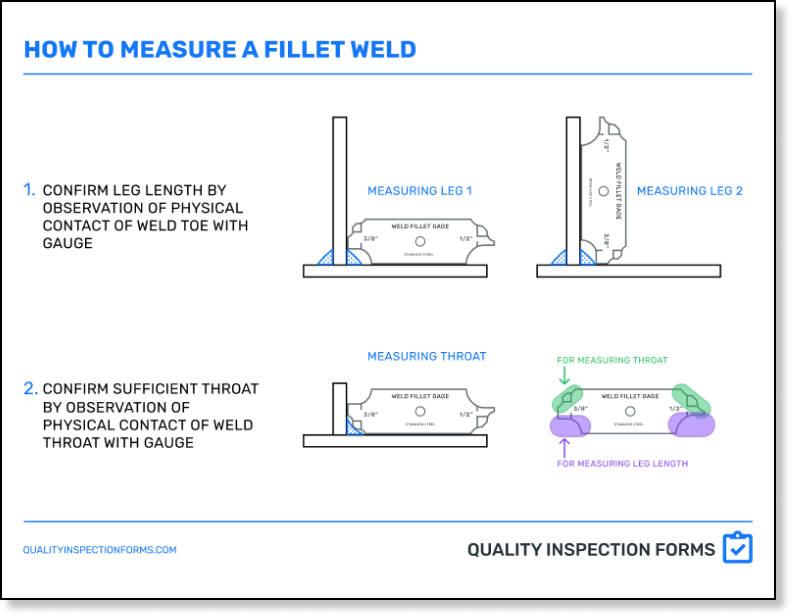The Ultimate Overview to Fillet Weld Quality Control: Making Certain Stamina and Durability in Your Welded Joints
In the world of welding, making sure the stamina and resilience of fillet welds is vital for the integrity of bonded joints. The quality assurance procedures applied during the welding process can dramatically affect the architectural stability of the end product. From the choice of appropriate products to the precise inspection of welds, each action plays a crucial function in establishing the overall top quality of the weld joint. As we begin on this expedition of fillet weld quality control, we will discover essential elements that affect weld toughness, delve into efficient examination methods, and talk about approaches for preventing common weld problems. Remain tuned to uncover just how mastering these methods can raise the toughness and integrity of your welded joints.
Value of Fillet Weld High Quality Control
Making certain proper fillet weld top quality control is extremely important in assuring the architectural integrity and long life of welded parts in numerous markets. Fillet welds are frequently utilized in structural steelwork, bridges, pressure vessels, pipes, and various other critical infrastructure where the strength of the weld is essential to overall safety and efficiency. Quality assurance procedures such as aesthetic inspections, non-destructive testing, and adherence to welding procedures help determine potential defects like absence of fusion, incomplete penetration, damaging, or too much support.
Key Factors Influencing Weld Stamina
Accomplishing ideal weld strength calls for mindful consideration of various vital variables that influence the honesty and longevity of the bonded joint. The initial important factor appertains joint prep work, which involves cleaning up the base steels to remove any type of impurities that could damage the weld. Furthermore, the fit-up of the joint is essential to make certain proper penetration and blend of the filler product.
The selection of the proper welding strategy and parameters likewise plays a significant function in determining weld stamina. Factors such as heat input, travel rate, and electrode angle can influence the quality of the weld. Furthermore, keeping the proper interpass temperature throughout multi-pass welding is essential to stop fracturing and ensure a strong bond between the layers.
Additionally, the option of filler product and its compatibility with the base metals is vital for attaining high weld toughness. Using filler material with the appropriate mechanical buildings can boost the total stability of the weld. Finally, post-weld warm treatment and appropriate evaluation techniques are important steps in ensuring the strength and resilience of the welded joint.
Examination Techniques for Weld Stability

One more essential examination technique is fluid penetrant testing, where a fluid dye is used to the weld surface - Gauge Fillet Weld. The dye seeps right into any surface-breaking flaws, making them noticeable under UV light. This technique works for discovering problems that may not show up to the naked eye


Ultrasonic testing is additionally extensively used for checking weld integrity. High-frequency audio waves are directed right into the weld, and any type of interruptions in the sound wave pattern show possible flaws like cracks or absence of blend.
These evaluation approaches play a vital function in making certain the quality and dependability of welds, inevitably contributing to the general toughness and durability of welded joints in commercial setups.
Avoiding Common Weld Flaws
In order to preserve the architectural stability of welded joints in right here industrial applications, it is vital to implement safety nets to resolve usual weld defects. One common problem is absence of blend, where the filler product falls short to bond properly with the base metals, resulting check out here in weak points in the weld. This can be protected against by making certain proper heat control and using the correct welding technique.
Another regular concern is porosity, caused by gas entrapment in the weld steel throughout the welding process. To avoid this, it is essential to clean the base steels extensively, make use of completely dry electrodes, and keep an ideal welding atmosphere with appropriate air flow.
Additionally, fractures in welds can endanger the joint's toughness. To avoid this flaw, it is very important to manage the cooling price after welding, make use of pre-heating when needed, and choose appropriate welding parameters.
Enhancing Bonded Longevity With Proper Techniques
One essential approach to enhance weld longevity is to guarantee correct weld bead placement. By placing the weld grain accurately within the joint, the weld's stamina and resistance to exhaustion can be dramatically boosted.
Selecting the best filler metal and guaranteeing the tidiness of the base steels can avoid incorporations and various other flaws that can endanger the weld's longevity. By applying these correct methods, welders can guarantee that their welded joints show remarkable toughness and longevity, fulfilling the highest possible high quality requirements.
Conclusion
Finally, preserving high quality control requirements for fillet welds is crucial for making sure the strength and longevity of bonded joints. By understanding the vital variables impacting weld strength, making use of assessment methods for weld integrity, protecting against typical weld defects, and employing proper techniques, welders can enhance the overall sturdiness of their welds. It is critical to prioritize top quality control actions to generate durable and trustworthy bonded joints.
In the world of welding, making sure the stamina and longevity of fillet welds is critical for the honesty of welded joints. As we begin on this exploration of fillet weld high quality control, we will uncover necessary factors that affect weld toughness, dig right into effective assessment approaches, and go over techniques for avoiding common weld issues.Attaining ideal weld strength requires mindful consideration of various key elements that affect the honesty and resilience of the bonded joint (Gauge Fillet Weld).In verdict, maintaining high quality control requirements for fillet welds is critical for ensuring the strength and durability of bonded joints. By recognizing the key factors impacting weld stamina, using examination approaches for weld integrity, preventing typical weld problems, and utilizing appropriate techniques, welders can enhance the overall resilience of their welds